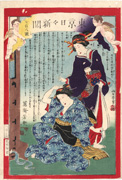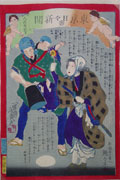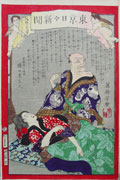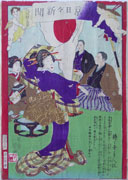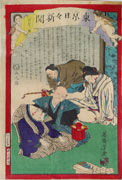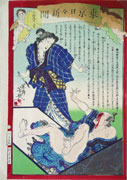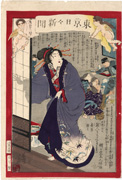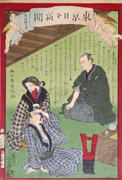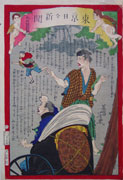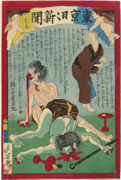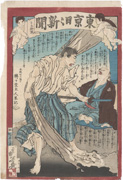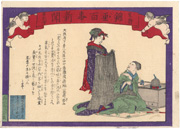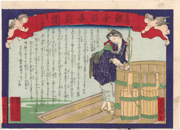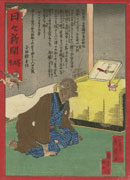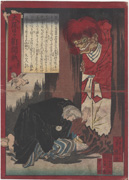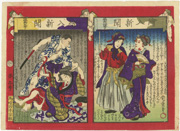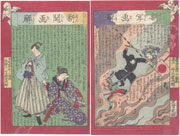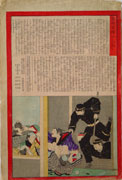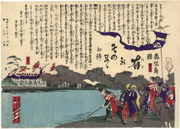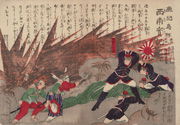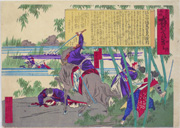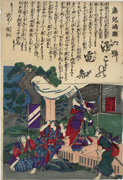Prints in Collection
No. 708 Tokyo Nichi Nichi Shinbun, 1874 IHL Cat. #2062 | 1874 IHL Cat. #458 |
Woman Cuts Off Lover's Nose, No. 892 Tokyo Nichi Nichi Shinbun, 1874 IHL Cat. #420 |
| Business Trip to Saga, Hizen Province, No. 913 Tokyo Nichi Nichi Shinbun, 1875 IHL Cat. #2061 | IHL Cat. #835 | IHL Cat. #402 |
IHL Cat. #606 | -intentionally left blank- |
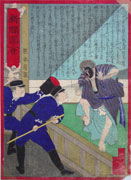 Police Confront Man in Black Makeup, 1875 Police Confront Man in Black Makeup, 1875Utagawa Yoshitaki (1841-1899) Shinbun zue (Osaka-based) IHL Cat. #311 | IHL Cat. #487 | Monster Reforms Mayor, No. 8 c. 1875 Hasegawa Sadanobu II (1848-1940) Ōsaka Nichinichi Shinbunshi IHL Cat. #1742 |
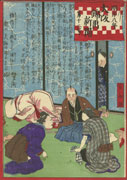 Wedding Protest, No. 12, 1875 Wedding Protest, No. 12, 1875Utagawa Yoshitaki (1841-1899) Osaka nishikiga shinbun IHL Cat. #486 | Nishiki-e Shinbun, Yomiuri Shinbun No. 9, Illustrations No. 24 and No. 25, 1875 Morikawa Chikashige (ac. 1869-Jan. 1882) Yomiuri Shinbun IHL Cat. #1904 | IHL Cat. #2437 and #2438 |
Kinoshita Hironobu II
(1844-?)
Nishikie shinbun (Kyoto-based)
IHL Cat. #310
Reports about Satsuma Rebellion
| IHL Cat. #2169 | newspaper unknown IHL Cat. #709 | The Huge Win of the Armed Forces, 1877 Hasegawa Sadanobu II (1848-1940) Ari no Sonomama (Osaka-based) IHL Cat. #567 |
True News from Kagoshima-ken,
No. 6, March 1877
newspaper unknown
IHL Cat. #2184
The Rise of Daily Newspapers
With the end of the Tokugawa shogun government in 1868 and the beginning of the Meiji reformation, which sought to modernize and Westernize Japan, the Meiji government sought to create an informed citizenry. Along with the establishment of compulsory education in 1872 the government encouraged the fledgling Japanese press to "write for commoners… and to speed the people along the path of 'civilization and enlightenment' (bunmei kaika)."1 Many early Meiji officials saw newspapers as “tools to be used … [and] bureaus and bureaucrats alike ‘financed and established’ newspapers quite generously, and the early 1870s saw the emergence of a press that was, essentially, an arm of the government."2
Broadening Readership
The first daily newspaper to develop a sizable readership (5.5M copies annually by 1877)3 was Tokyo’s Yomiuri Shinbun, first published on November 2, 1874. In order to reach a less educated readership, it augmented its kanji writing (which could only be read by the better educated) with furigana, the phonetic aids intended to make kanji characters easier to understand.4 Competing for readership with the Yomuri shinbun were a number of daily papers including the Tokyo mainichi shinbun, the Tokyo nichinichi shinbun and the Yubin hochi shinbun.
In addition to reporting on political and social/moral issues to enlighten the population, the dailies covered more sensational events such as spectacular fires, mad-dog attacks, ghost reports, miraculous recoveries, and crime [e.g. "poison women" (dokufu) stories about women who gained notoriety for crimes ranging from fraud and extortion to murder.] These stories, of course, increased readership and built circulation.
Woodblock Prints and the Press
At the same time that the daily newspapers were trying to increase circulation, the woodblock industry, consisting of publishers, book/print stores, artists and craftsmen, were looking for ways to revive their flagging sales. One way that served both industries was to take the juiciest stories from the dailies and illustrate them with colorful single sheet woodblock prints published under the auspices of the newspapers. These woodblock prints called nishiki-e shinbun (“brocade picture newspapers”) included both text and pictures and sold for between 1.6 to 2 sen (a sen is 1/100 of a yen), making them affordable to ordinary working people.5 The text was mostly written, using furigana and katahana to enhance readability,6 by popular writers of light novels7 and the pictures were drawn by woodblock print artists of the day, such as Tsukioka Yoshitoshi (1839-1892), who mainly drew for the Yubin hochi shinbun and Utagawa Yoshiiku (1833-1904), who mainly drew for the Tokyo nichinichi shinbun, which he co-founded in 1872.
While the Tokyo nichinichi shinbun was the first paper to publish news nishiki-e, many other print publishers in Tokyo and Osaka jumped into the news nishiki-e market adopting a similar masthead design, featuring the name of their news nishikie on an unfurled banner held in the air by a pair of fat cherubs.
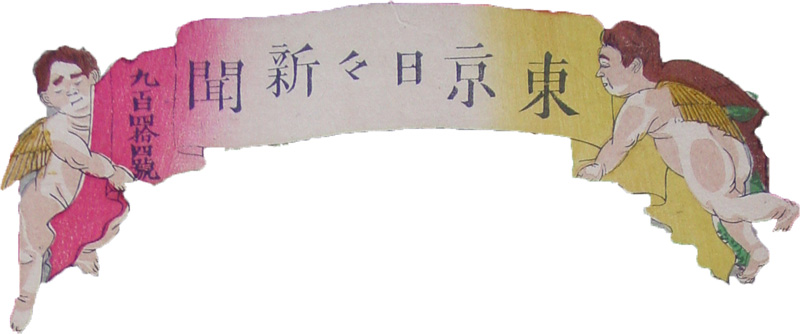
Tokyo nichinichi shinbun nishiki-e masthead

Osaka Kankyo, Nishiki-e Hyakuji Shinbun masthead
At their brief height, around 40 nishiki-e shinbun were in publication.8 While nishiki-e shinbun were largely gone by the late 1870s, challenged by the rise of faster and cheaper letterpress newspapers, they played an important role during their short life in spurring the growth of the Japanese press during its formative years.
For a comprehensive look at nishiki-e shinbun go to William Wetherall’s web site www.nishikie.com. For a scholarly analysis of nishiki-e shinbun see "[The] Art of Reframing the News: Early Meiji Shinbun Nishiki-e in Context", Chelsea Foxwell, appearing in the Harvard Journal of Asiatic Studies, Volume 78, Number 1, June 2018, p. 47-90 https://doi.org/10.1353/jas.2018.0004 For an extensive display of nishiki-e shinbun go to https://cultural.jp/search?id=arc_nishikie-MSZB07_08_408_00001Nr134080a.
1 Creating a Public: People and Press in Meiji Japan, James L. Huffman, University of Hawai’i Press, 2006, p. 8.
2 Ibid., p. 51.
3 Ibid., p. 60.
4 Ibid., p. 89.
5 “When News Became an Art Form,” unattributed, 2003.10.29 online newspaper of Mitsubishi Electric Company Taste of Japan http://global.mitsubishielectric.com/tasteofjapan/brushstrokes/arts.html
6 “News Nishikie: An Arranged Marriage That Didn't Last,” William Wetherall and Mark Schreiber, http://members.jcom.home.ne.jp/yosha/nn/articles/Andon_2006_news_nishikie.html
7 Japanese Popular Prints: From Votive Slips to Playing Cards, Rebecca Salter, University of Hawai’i Press, 2006, p. 61.
8 Okayama City website https://www.city.okayama.jp/kurashi/0000009409.html
last revision:
4/14/2021
11/18/2020
6/19/2020
